
Home phone: (408) 749-8522
e-mail: doug@dougronald.com
Doug Ronald and The Wall of Sound
I'm a big fan of classical pipe organ which produces tones from 16.7 Hz up through several thousand Hz. In order to reproduce that range, I knew the loudspeaker system would be large. Here is the story of the design and construction of my final stereo.
Pictures first in case you're curious...
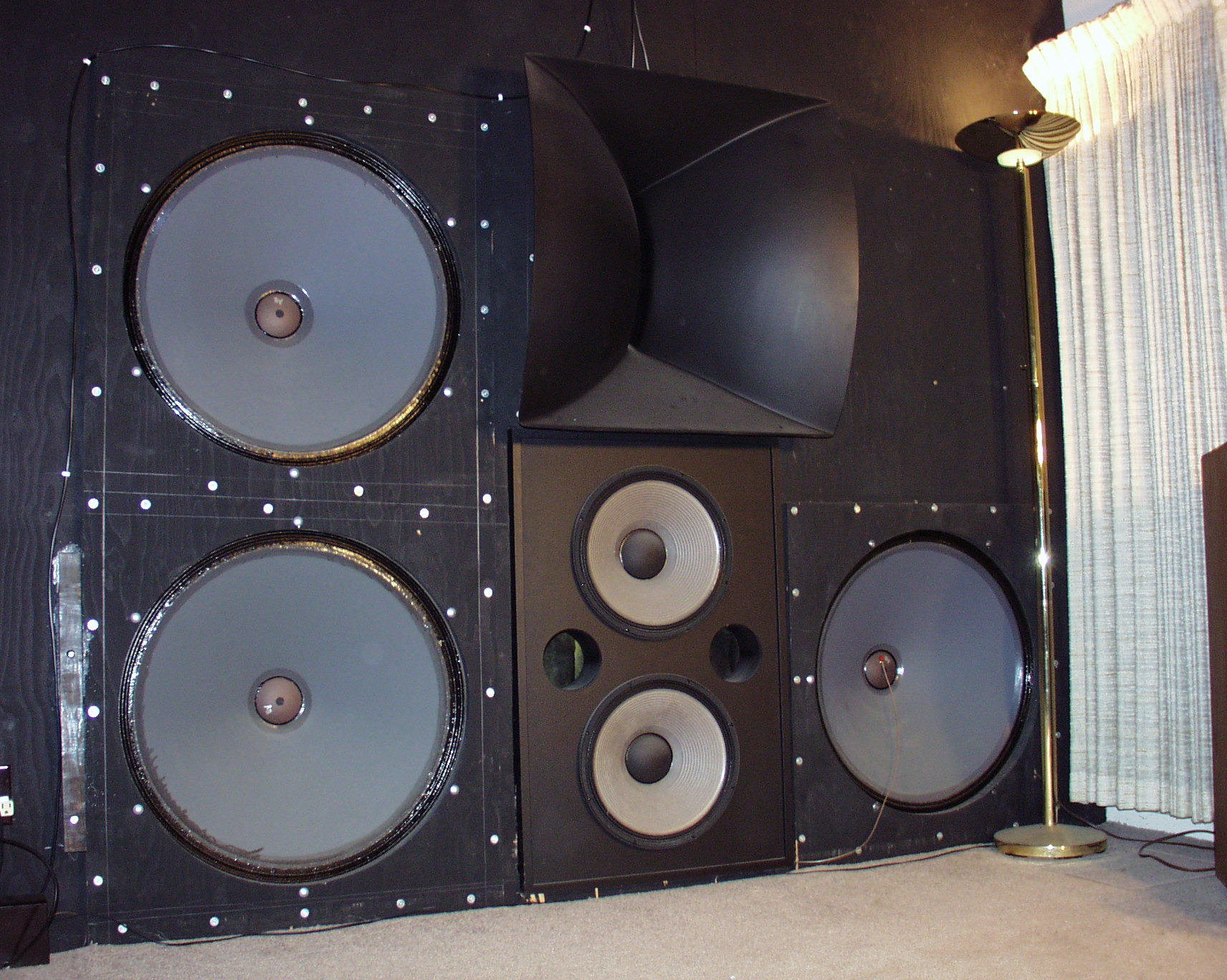
Right Channel
Each channel contains three 30" woofers, and a JBL 4675C THX certified theater cabinet system. There originally was an accelerometer glued on one Electro Voice 30W drivers on each side, but later removed. (see lower right driver)
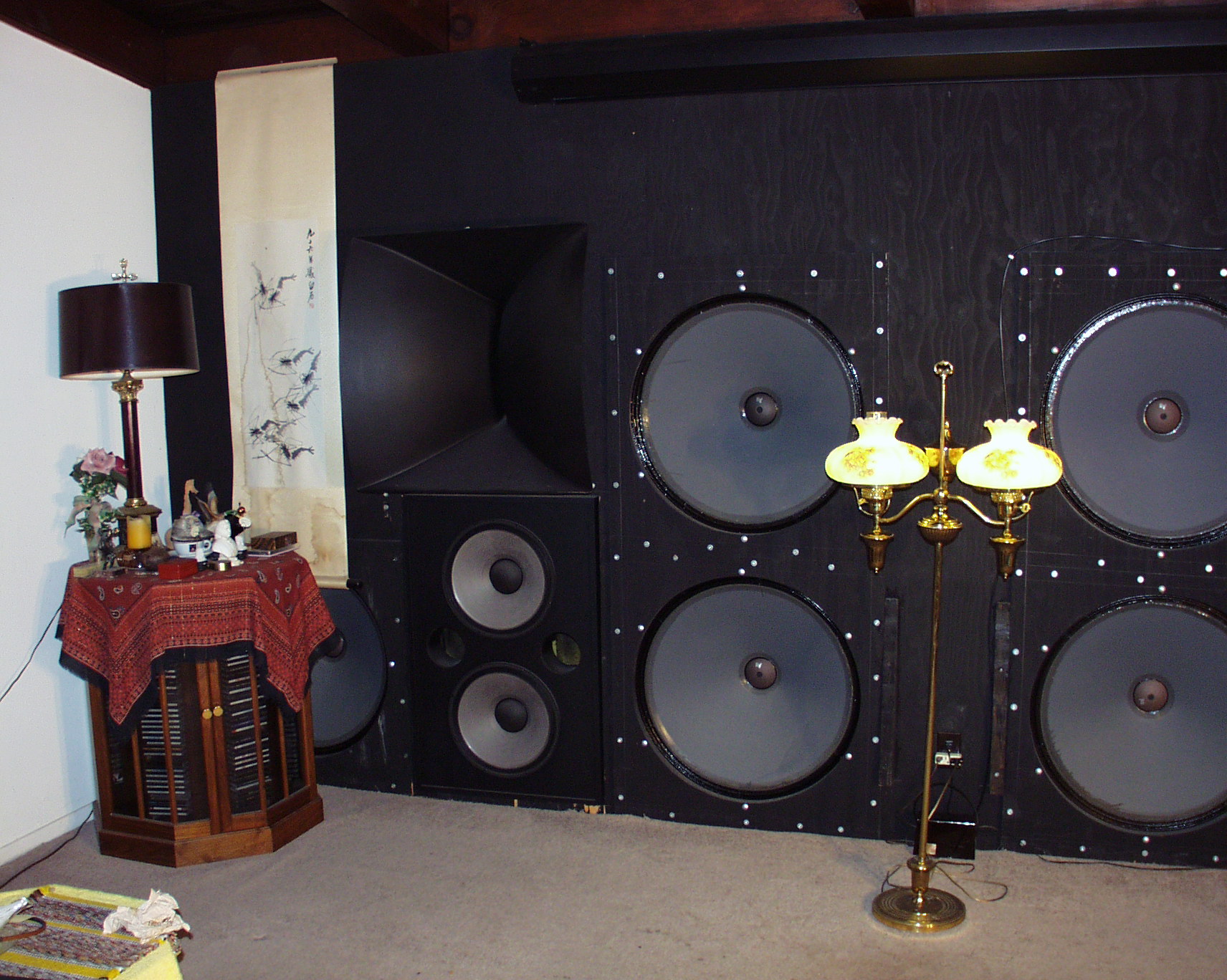
Left Channel
The identical left channel.
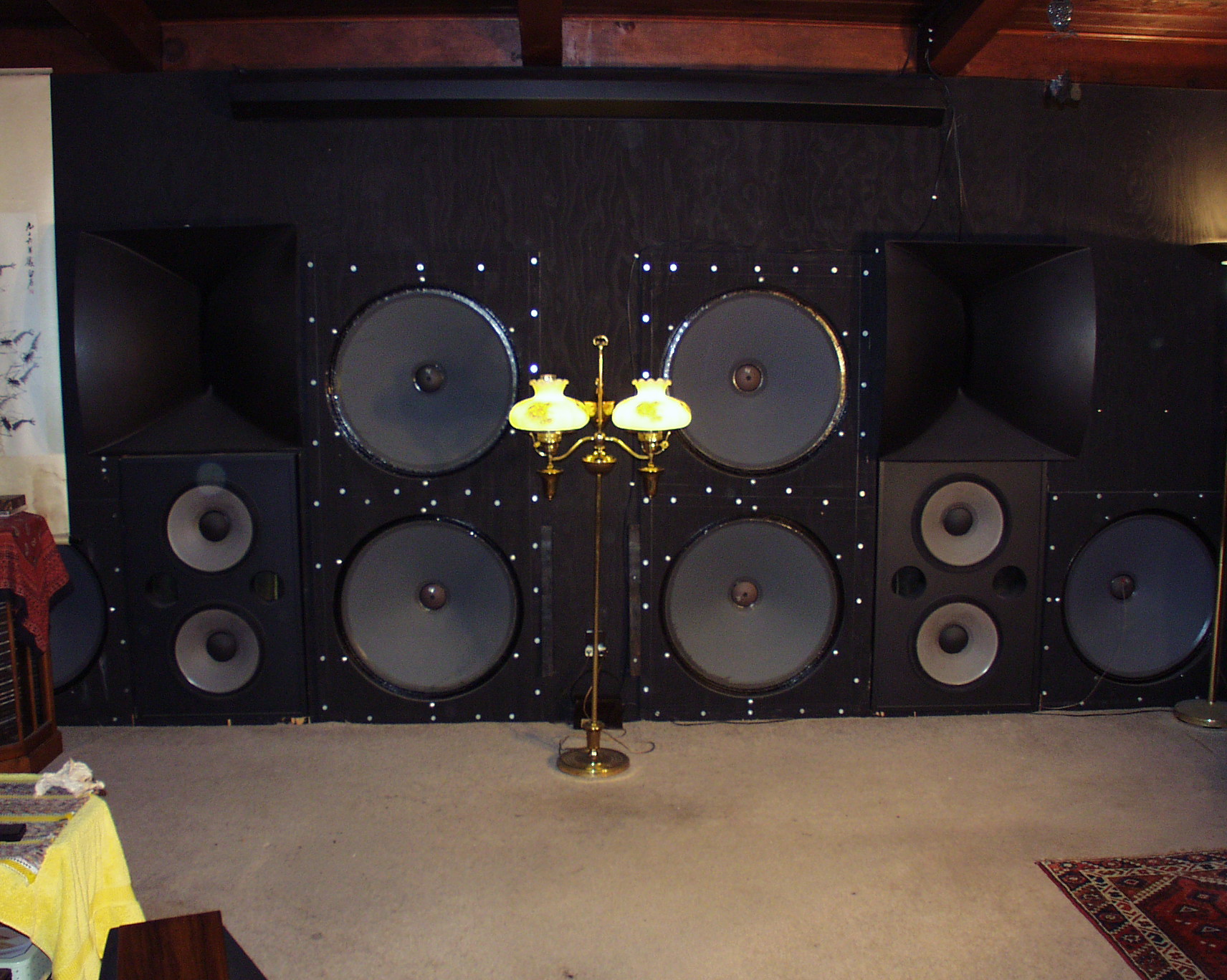
Full-on view
Entire wall is the enclosure's surface. There is an 84 inch screen above the center woofers which deploys between them for viewing DVD movies.
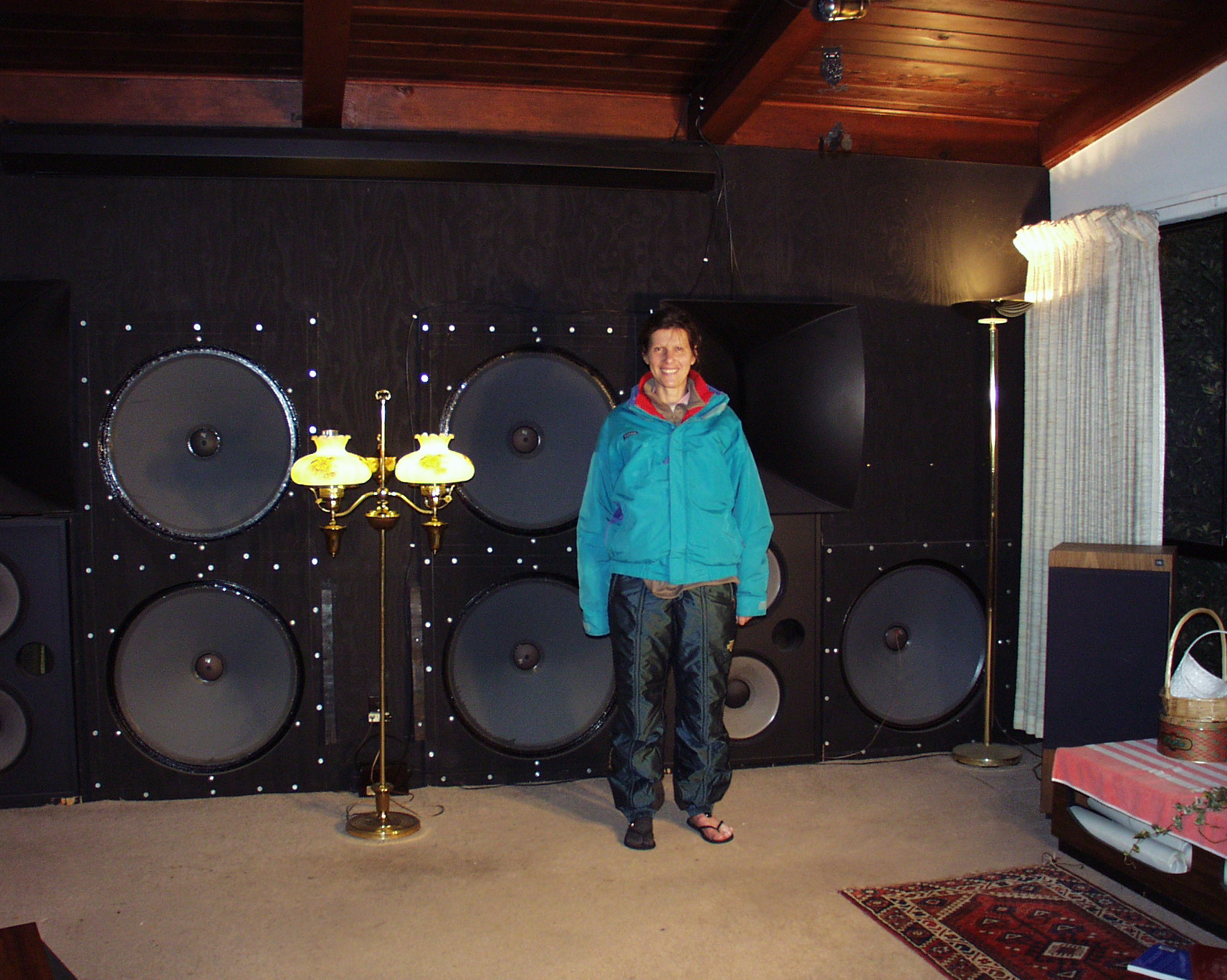
Kristin
Here is Kristin for a size perspective. Where is your other sock? Now that I've spent all my coin on the Hi-Fi, we can't afford to heat the house, so Kristin has to wear a snowsuit indoors...
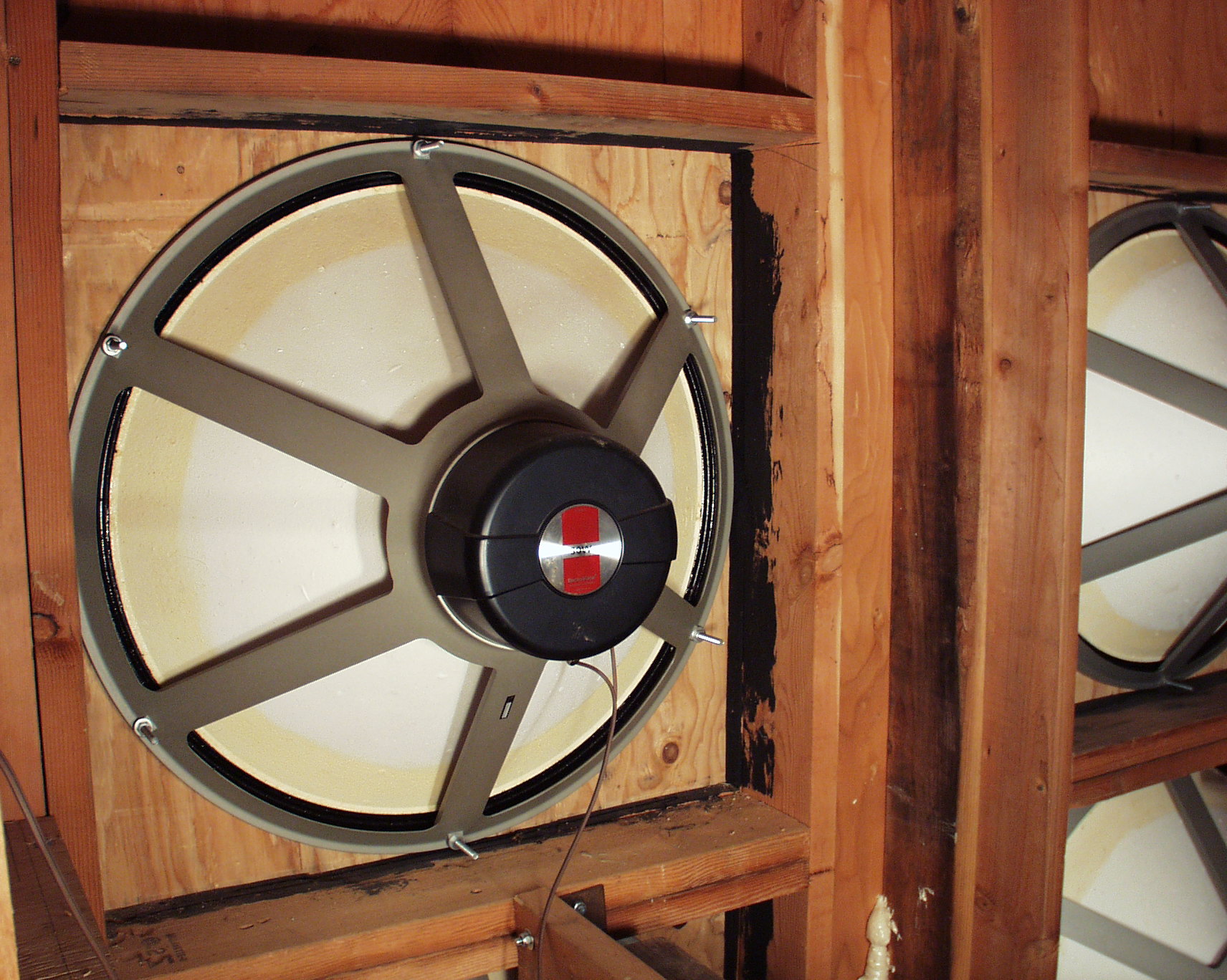
EV 30W 30 inch driver
Here is a view of the backside of the 640 cu ft subwoofer enclosure.
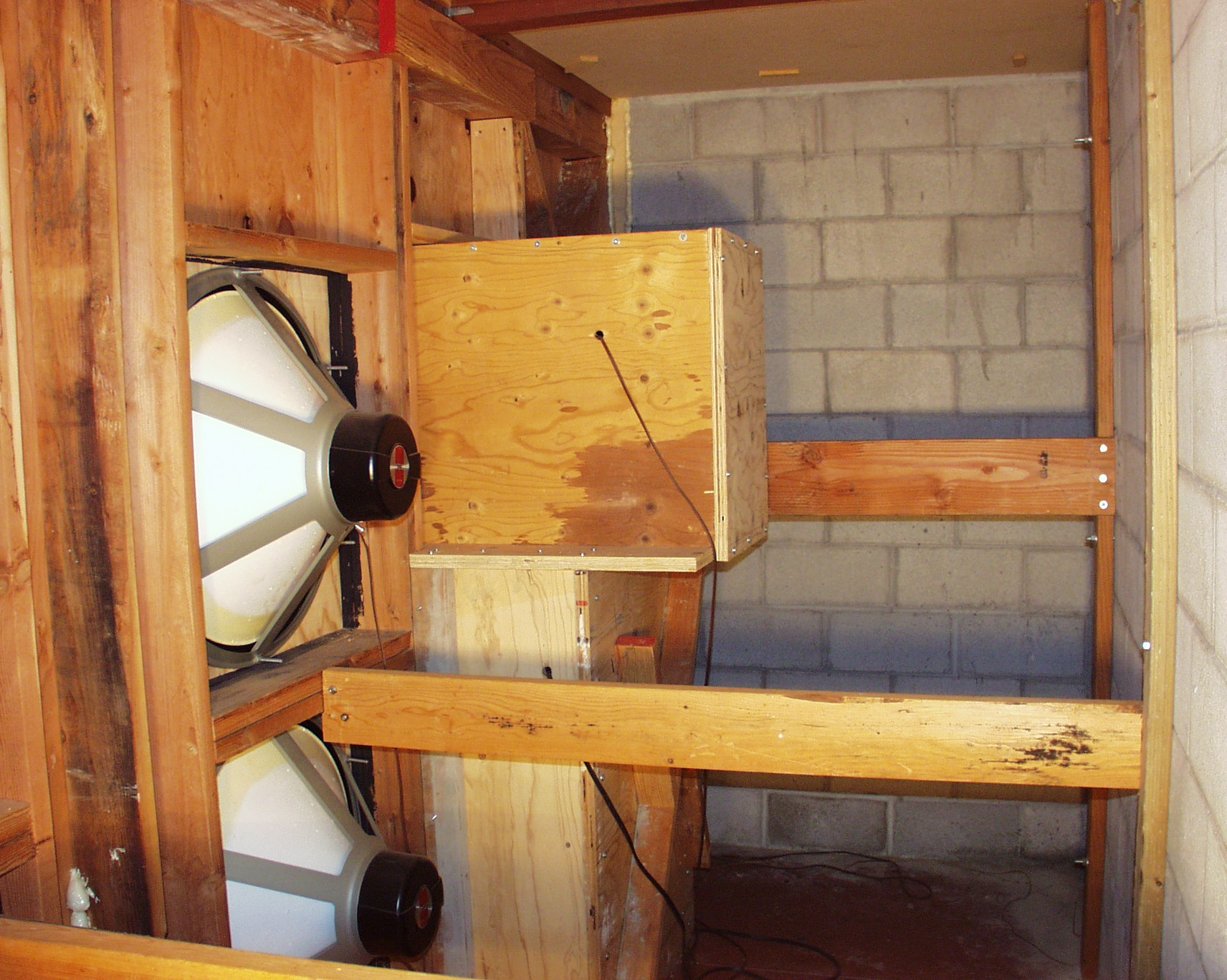
Enclosure Left Channel
The subwoofer enclosure is 640 cubic feet in volume, and has four sides of solid concrete to eliminate resonances. The boxes seal-off the front side where the JBL theater speakers sit. In this image there is no sound deadening material, but I have added fiberglass insulation to the entire inner surface now and eliminated the accelerometer sensors. The fiberglass has smoothed-out the response enough to not bother with the accelerometer feedback electronics.
High School
I built a front-loaded horn system with a large infinite baffle behind two 15" low frequency drivers. I had saved my money to buy two Stromberg Carlson 15" drivers with bright red cones and fairly large voice coils. I was disappointed to discover that they had relatively high free-air resonances. I steamed some thin plywood boards and bent them into roughly an exponential curve as per plans I found in an early edition of Audio Magazine. The high-frequency section was an Altec Lansing horn whose model was an 811B, and the driver was a 288C. I only had monophonic sound, but it certainly could achieve high sound pressure levels, at least above 50 Hz.
College
While in college, I improved the front-loaded horn by doubling the volume in the infinite baffle, but this system still lacked the bass response I longed for. I also tried to build a system called "Ton-and-a-Quarter of Sound" from a design in Audio Magazine. This system used thin-wall concrete for both the bass and treble sections of exponential-sectoral horns. The high frequency unit used an Altec 288C as the driver and the bass horn used two Jensen 15" drivers. Despite significant help from the author, I never completed the moulds from which the enclosures themselves were to be cast.
Employed
After having worked a couple years, I was able to purchase the Infinity IRS or Infinity Reference Standard. (Picture of left side) I was the proud owner of serial number 4. This was a beautiful Rosewood system with two towers containing six 12" woofers each, and two curved panels with electromagnetic flat panel drivers. There were, as I remember, 24 of them in a vertical linear array per side. The response above 40 Hz or so, was flat, and extended beyond my hearing range to something like 40 KHz they claimed. These physically beautiful speakers did not reproduce organ tones down in the low registers at adequate volume levels. The low frequency towers had built-in amplifiers and there was an accelerometer glued onto one woofer of each side. After a week of playing the system, I remember the start of many problems in their design, beginning with the left side's glued-on accelerometer falling off of the cone. Infinity supplied me with the schematics of the system, and I had numerous repairs and modifications to their electronics, most of which were in the accelerometer amplifier and integrator stages. I re-glued the accelerometer onto the voice coil dust cover and also touched-up the other side, which ended the physical problems. I paid $22K for this system and unloaded it for $14K a couple years later to some guy in Santa Monica who was thrilled to obtain it. Just the packing crates alone, all custom made and felt lined, were something to behold.
2nd Last Attempt
I was still enamored with horns and purchased an Altec Lansing theater system (similar to the A6 shown in the link, but twice as many drivers) with four very imposing plywood enclosures, and two large aluminum horn high frequency units. The low frequency units had four 15" drivers per side, front horn loaded with a bass reflex design for frequencies below 100 Hz or so. The high frequency horns were exponentials with 291-16A drivers. Everything was bi-amped. The SPLs were very impressive, the response was anything but flat, and I still had negligible response below 50Hz.
Final Design
I knew from this many previous attempts, that I would need some low
frequency drivers that first of all, had a lot of cone area, and
second of all, had a low free-air resonance. I picked the Electro
Voice 30W driver (no longer in production) because
of its 30" cone diameter and also because its free-air resonance was
around 15 Hz. To get the proper SPLs to match the JBL mid and high
frequency drivers (see below), I choose three 30" drivers per front
side, for a total of six drivers. I enclosed them in concrete to
keep any wall resonances to a minimum, and also to attempt to keep
the sound enclosed and away from my neighbors tender ears. I
borrowed from Infinity, the idea of smoothing-out the response with an accelerometer,
and have one per side glued to the outer-most driver of the trio. I
use about 20 dB of negative feedback and have a flat response to
about 12 Hz where the system drops off rapidly. I deliberately force
the response to be 24 dB down at 5 Hz to keep the cone motion in
control where there is no back-air loading. Unlike the Infinity IRS
servo which was completely analog, my design digitizes the low
frequency channels of the
electronic crossover and my FIR filters,
integrators, and feedback servo, are all done with DSP. My sample
rate is only 8 kHz because I'm dealing with less than 100 Hz
signals. (24 dB per octave)
I cross this sub-woofer system over at 62 Hz, and above that, is a
pair of JBL 4675C-8LF theater loudspeaker systems. This is a
really flat (specs),
efficient, speaker system, THX qualified for use in theaters, and
not really expensive. I just don't understand why they are not more
popular with serious audiophiles. Sure they are large and imposing,
especially the exponential-sectoral horn, but their response is so
flat, they are hard to ignore. I cross the 15" drivers and the horn over at 500 Hz. All speakers
are separately amplified and the electronic crossover is a JBL
DSC-280 as mentioned. The 280 allows for
time-alignment of the non-planer speaker cones to keep the response
smooth. I highly recommend the DSC-280 as an electronic crossover. UPDATE I As of November 2022, I have replaced the JBL DSC-280 with a DriveRack
Venu-360 Loudspeaker Control System. This digital system allows the
user to implement driver time alignment, crossover frequencies and
levels, and with the optional exceptionally flat microphone,
automatic frequency response leveling. My response from 26 Hz
through 16 kHz is now within 2 dB at my listening location. This
amazing product intended for professional sound reinforconcrete
applications is the perfect fit for my system. Update II DriveRack Venu-360 Processor
January 2023 - The DBX Driverack VENU 360 sound processor is the best addition I have made to this system since the start of the project.
This is a commercial sound reinforcment processor intended for large venues. It has crossover filters, parametric equalization, an octave doubler,
a self-contained auto-equalization feature with the addition of an additional cost microphone, and compression which I don't use in a home environment.
The companion microphone has a super-flat response, and is almost a lab standard in that regard. The down side is the microphone has limited dynamic
range. so isn't useful for professional recording. The software has the user move the microphone around the room where a chirp sweeps the audio
spectrum at each location, and finally the program computes the parametric equalization filters to give the flattest response for the environment. Of
course the user can tweek that response, like add a slight bass boost or a treble boost for the hard of hearing like me. This unit is just an amazing
piece of equipment and my congratulations to the engineer(s) who designed it and programmed the firmware.
This new processor replaces the old DSC-280.
My high-frequency amplifier and my mid-frequency amplifier (left and
right front) is a pair of Yamaha M-85s which I'm guessing are around 250 watts per channel each.
Each set of Electro Voice 30W drivers (3 per set) is driven from one
Adcom GFA-555. Each GFA-555 is a pair of 200 RMS Watt amplifiers. I
use two additional GFA-555s for the front and rear surround
amplifiers.
I have no preamp. The output of the CD player which is a Yamaha
CDX-5000, feeds the JBL DSC-280 directly, thus avoiding any
superfluous electronics in the playback path. I set the volume by
using the remote for the CD player. The DSC-280 takes care of all
the Linkowitz-Riley phase and amplitude crossover responses, plus
the shelf amplitudes of each band-limited channel. It also includes
a limit function which I didn't used to invoke, but after feeling
the front pane-glass window excursion on some playback material, I
now have it set.
With regard to flatness, from 62 Hz through 16 kHz, the JBL THX spec
allows for a 3 dB variation. The listener must be within 20 degrees
of on-axis to the horns to get the 16 kHz which I always am where I
listen. From 12 Hz to 62 Hz, I have a 5 dB variation, probably due
to the room's contribution to standing waves. The big advantage to
this design over other "over-the-top" designs, is the sound pressure
level (SPL) in the 16 to 64 Hz that this one can achieve. I have
heard no other system reproduce the low C (16 2/3 Hz) to C (33 Hz)
octave at such high SPLs. With heavy pipe organ music, I can not
tell the difference between being in a large cathedral and being in
my living room, which is why I went to all the trouble in the first
place. I can play the volume realistically and truly duplicate the
sound I hear live, or crank it up, and vibrate the pictures off the
walls. There is the lead-in to the Telarc CD "Time Warp"
(CD-80106) which includes a synthesizer producing the low notes from
Richard Strauss' "Also Sprach Zarathustra", that at high SPLs scares
me because the front pane-glass windows are moving about one-quarter
inch at their centers. I realize at some excursion, they will
sustain an expensive crack, so on this CD, Wellington's Victory, and
any 1812 Overture CD, I pre-play the tracks to find a safe volume
level.
This system is my final system. I have had it untouched for going-on
five years, and will die with it, although it may get transported to
a new home when I move. I have added surround, and will recreate it
when I move to my retirement home. I will make one modification to
the design when I move, and that is to excite the room with the low
frequency energy from the corners of the room. I now have the low
frequency drivers on a flat surface (see
pictures) and suffer from room standing waves.
Exciting the corners and carefully picking the room dimensions will
lessen this phenomenon. My planned playback system/home theater room
is 42'W x 57'L x 30'H.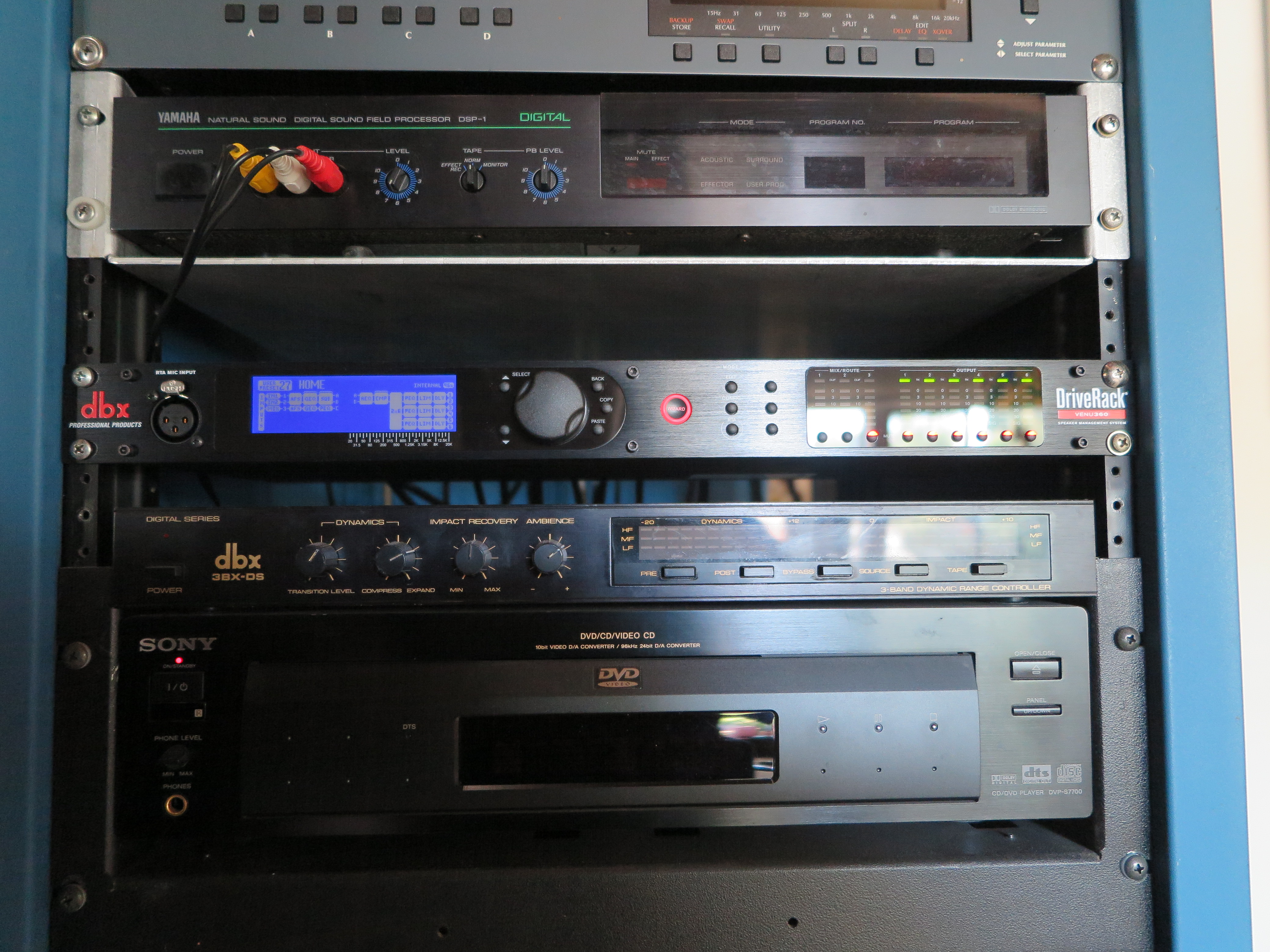
What about specs?
After all this expense and effort, am I happy?